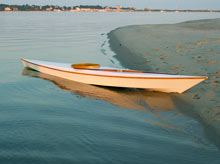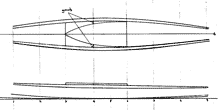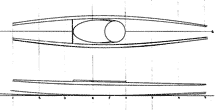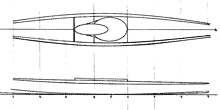I was a bit chagrined when Chuck first introduced Egret as “the perfect boat.” I had hoped not to peak so early. I wouldn’t want to discourage his use of superlatives, but there are a few changes that might benefit some builders. I’m not talking about turning a seventeen-foot long, two-foot wide kayak into a fourteen-foot long, three-foot wide one, although if you backed a car into it just right you might be able to accomplish that. Instead, I’m talking about the cockpit configuration.
 |
I was a bit chagrined when Chuck first introduced Egret as “the perfect boat.” I had hoped not to peak so early.
click thumbnails for larger views |
Getting in and out of a kayak is often the most challenging part of the experience. As a featherweight descendant of arboreal primates, I have an inherent difficulty imagining the personal space requirements of larger members of our species. Buoyancy calculations are one thing, but the formulae for stuffing long legs into a kayak cockpit are conspicuously absent from the literature of boat design. Arctic natives had many rules of thumb, arm, hip, etc., for the sizing of their kayaks, but it seems that native paddlers were generally expected to thread themselves into a relatively small and circular “manhole” as it is sometimes called. Not all modern kayakers want to do that.
Egret is stylistically reminiscent of Greenland boats, but I tried to make the cockpit of a somewhat larger than traditional size that would be more convenient for the average modern paddler. Despite my good intentions, I came up a bit short of what I had hoped for. Experienced kayakers can and do slide easily into her cockpit, but the less gymnastically inclined sometimes find it a bit daunting at first. In an attempt make Egret more accessible to a greater number of people I have sketched three additional cockpit configuration options: the Bullet, the Long Oval, and the Keyhole. It is not just their additional length that makes these cockpits easier to enter. Each requires that the frame at station 4 be cut away at the top, as is done amidships at station 5, which makes it that much easier to feed one’s legs and knees into the boat. The shapes shown here are just general ideas and could be built to any size that suits the individual paddler.
The Bullet |
 |
A bullet-shaped cockpit is the easiest of the three options. It’s the shape found most often in non-arctic skin kayaks: picture Percy Blandford’s designs, or the boats in George Putz’s Wood and Canvas Kayak Building. Unlike the other configurations, the bullet needs no steaming of the carlins or coamings. For the carlins, two 1/4” x 1 3/4” strips of wood are bent from the aft ends of the cockpit opening into the apex. After the fabric is on, the coamings are installed the same way. The joinery can be an epoxy fillet or a work of art (or both) depending on the builder’s inclination. I would add small plywood gussets between the deck stringers and the frame forward of station 4 to keep the frame from bending as the carlin is eased into place. The forward deck king terminates against the frame at station 3, and it is opposite this that the cockpit apex rests. I wouldn’t make a bullet cockpit any shorter than this, as it would defeat the purpose.
The Long Oval |
 |
The long oval is an enlargement of the stock cockpit. As drawn here, it extends a little over halfway forward toward station 3. It could be longer, but if it lands short of station three, a crossbeam (masik?) of stringer stock should be glued between the deck stringers at its forward end. The forward deck king will terminate against that. The long oval is laminated in the manner of the stock cockpit, with two 1/8-inch layers for the carlin and the same for the coaming. Freehand installation of hot strips of wood is discussed in the instruction book that comes with Egret’s plans and patterns, or one might try shaping the carlin around a form, a notion discussed below.
The Keyhole |
 |
A keyhole cockpit is shaped so as to keep the opening to a minimal size yet still provide some room to fold the legs into the necessarily small space a kayak affords, and also to get them out in a hurry if necessary. It provides more deck area than other long cockpits, under which one can install foam pads for knee bracing. The reverse curves of a keyhole configuration would challenge freehand bending and thus this carlin should be shaped around a form.
Shapes and Forms |
 |
The wooden sides of guitars and other stringed instruments are bent around forms, and the same principle can be applied to the making of kayak cockpits. After the cockpit shape has been determined on paper, cardboard, hardboard or luan, the form can be cut from layers of plywood or composition board, which are fastened one exactly above the other through spacers or another ply sufficient to match the 1 3/4-inch depth of the carlin. The form should be 1/4-inch smaller than the outside dimension of the carlin to allow for the thickness of the laminates. The form itself might be mounted on another larger board or secured on a bench.
Clamping the carlin laminates around a form is fairly easy with an oval; a nylon webbing band clamp will do. The keyhole shape is more difficult because of its reverse curves. The form for a keyhole carlin would most likely be mounted on another board, into which holes have been bored to hold the dowels (or plastic rods, to shed glue) that will hold the laminates in place. The rods themselves might be sleeved in removable plastic tubing having an eighth-inch wall to accommodate the additional width of the second laminate. A bending strap, a thin band of metal wrapped around the outside of the steamed strip, can keep a laminate from splitting when coerced. The steel bands used to secure loads of lumber work well and can be had for nothing. The bending might be done in stages, starting with the sharpest curve at the forward end of the cockpit. The remaining portions can be reheated in turn. See this website for a look at how it’s done at the lutherie.
Deriving the shape of the cockpit is an interesting exercise. The oval cockpit is not likely to be a true oval, but more of an ovoid, an egg shape, wider aft than it is forward. It can be formed by overlapping and connecting two ovals of different size and foci, or an oval and a circle. A keyhole shape can be formed from two ovals. One could make the circles and ovals full-size on cardboard using traditional methods (compass or trammel for circles; two nails, string loop and pencil for ovals) or print computer-generated shapes on a grid and scale them up. The cockpit could also be drawn freehand, one half only, on a piece of folded paper, with the fold aligned along the longitudinal centerline of the boat. This pattern can then be transferred to the form. Whatever shape you end up with, just remember that it’s harder to bend wood into or around tight corners (small radii) without splitting.
The Carlin
If you have used a form to make the carlin, use the finished carlin as a pattern for marking where to cut away the frame tops and where to position the crossbeam. Mark the longitudinal centerline to make sure the carlin is aligned fore-and-aft and side-to-side. Cuts in frames should match the angle at which the carlin intersects the frame. If it fits snugly (and it should) glue it in place using generous epoxy fillets. If it’s a bit loose, clamp temporary cross-spalls (covered with cling wrap or waxed paper) under the carlin to support it in place while the glue cures.
The Coaming
Installing the carlin is the last step in the construction of an Egret frame before it is covered with fabric. The coaming is added after the fabric is complete. The “stock” Egret coaming is built with 1/8 inch laminates, just as the long oval and keyhole would be. The bullet coamings should be two 1/4-inch thick pieces, one on each side. Height is a matter of judgment for all configurations. Too low provides little protection and too high looks dorky, but if one anticipates using a spray skirt often, a low coaming with a wide, sturdy rim might be appropriate. Whatever the configuration, a cardboard mockup can be helpful prior to actual cutting of wood.
Judging from the sketches, it appears that these modifications won’t wreak esthetic havoc on Egret’s fine lines. I haven’t yet tried building a carlin around a form, but that’s because I just thought of it while writing this article. These are mostly brand-new ideas, and I fully expect that intrepid builders will get to try them out before I do.
***
Plans for Egret are available at Duckworks - Click HERE
|

